FY•X is a leading China high quality 16S 60V 40A Smart BMS for Automated Guided Vehicle manufacturer, supplier and exporter.Revolutionize your Automated Guided Vehicles with our state-of-the-art 16S 60V 40A Smart BMS by FY•X. Elevate efficiency and reliability through cutting-edge technology. Connect with our trusted suppliers in China to drive your AGV solutions into the future!
This FY•X high quality 16S 60V 40A smart BMS for Automated Guided Vehicle is a protective board solution specially designed by Wenhong Technology Company for power supply 15-16 string battery packs. It is suitable for lithium batteries with different chemical properties and different numbers of strings, such as lithium ion, lithium polymer, lithium iron phosphate, etc.
BMS has two communication interfaces, RS485 and CAN (choose one of the two), which can be used to set various protection voltage, current, temperature and other parameters, and is very flexible.
The protection board has strong load capacity and the maximum sustainable discharge current can reach 40A. The protection board has LED power indicator and system operation indicator light, which can conveniently display various statuses.
● 16 batteries are protected in series.
● Charging and discharging voltage, current, temperature and other protection functions.
● Output short circuit protection function.
● Three-way battery temperature and FET temperature detection and protection.
● Passive balancing function.
● Accurate SOC calculation and real-time estimation.
● Protection parameters can be adjusted through the host computer.
● CAN communication can monitor battery pack information through the host computer or other instruments.
● Multiple sleep modes and wake-up methods.
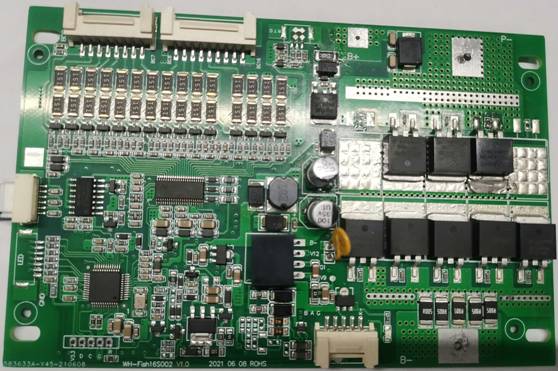
Real picture of the front of the BMS
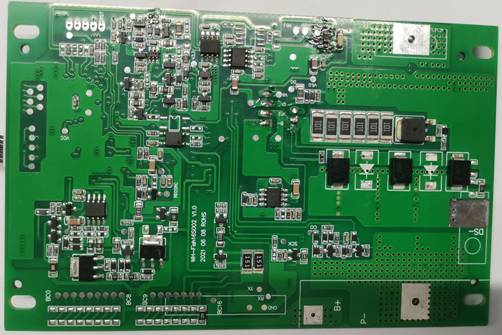
Real picture of the back of BMS
|
Details |
Min. |
Typ. |
Max |
Error |
Unit |
||||||
|
Battery |
|||||||||||
|
Battery Gas |
LiCoxNiyMnzO2 |
|
|||||||||
|
Battery Links |
16S |
|
|||||||||
|
Absolute Maximum Rating |
|||||||||||
|
Input Charging Voltage |
|
67.2 |
|
±1% |
V |
||||||
|
Input Charging Current |
|
20 |
30 |
|
A |
||||||
|
Output Discharging Voltage |
33.6 |
43.2 |
67.2 |
|
V |
||||||
|
Output Discharging Current |
|
40 |
|
|
A |
||||||
|
Continuous Output Discharging Current |
≤40 |
A |
|||||||||
|
Ambient Condition |
|||||||||||
|
Operating Temperature |
-40 |
|
85 |
|
℃ |
||||||
|
Humidity (No Water-Drop) |
0% |
|
|
|
RH |
||||||
|
Storage |
|||||||||||
|
Temperature |
-20 |
|
65 |
|
℃ |
||||||
|
Humidity (No Water-Drop) |
0% |
|
|
|
RH |
||||||
|
Protection Parameters |
|||||||||||
|
Over-Charge Voltage Protection 1 (OVP1) |
|
4.220 |
|
±30mV |
V |
||||||
|
Over-Charge Voltage Protection Delay Time1(OVPDT1) |
|
2 |
|
±2 |
S |
||||||
|
Over-Charge Voltage Protection 2(OVP2) |
|
4.300 |
|
±30mV |
V |
||||||
|
Over-Charge Voltage Protection Delay Time2 (OVPDT1) |
|
4 |
|
±2 |
S |
||||||
|
Over-Charge Voltage Protection Release (OVPR) |
|
4.100 |
|
±50mV |
V |
||||||
|
Over-Discharge Voltage Protection 1 (UVP1) |
|
2.800 |
|
±80mV |
V |
||||||
|
Over-Discharge Voltage Protection Delay Time 1(UVPDT1) |
|
2 |
|
±2 |
S |
||||||
|
Over-Discharge Voltage Protection 2 (UVP2) |
|
2.500 |
|
±80mV |
V |
||||||
|
Over-Discharge Voltage Protection Delay Time 2(UVPDT2) |
|
8 |
|
±2 |
S |
||||||
|
Over-Discharge Voltage Protection Release (UVPR) |
|
3.000 |
|
±100mV |
V |
||||||
|
Over-Current Charge Protection 1 (OCCP1) |
|
60 |
|
±2 |
A |
||||||
|
Over-Current Charge Protection Delay Time1 (OCPDT1) |
|
3 |
|
|
S |
||||||
|
Over-Current Charge Protection Release1 |
Delay 30S automatic release |
||||||||||
|
Over-Current Discharge Protection0 (OCDP0) |
|
90 |
|
±5 |
A |
||||||
|
Over-Current Protection Delay Time0 (OCPDT0) |
|
5 |
|
|
S |
||||||
|
Over-Current Discharge Protection Release 0 |
Delay 30S automatic release |
S |
|||||||||
|
Over-Current Discharge Protection1 (OCDP1) |
|
144 |
|
±15 |
A |
||||||
|
Over-Current Protection Delay Time1 (OCPDT1) |
|
80 |
|
±20 |
mS |
||||||
|
Over-Current Discharge Protection Release 1 |
Delay 30S automatic release |
||||||||||
|
Short circuit current protection |
|
310 |
|
±20 |
A |
||||||
|
Short circuit current protection delay time |
|
200 |
|
|
uS |
||||||
|
Short circuit protection Release |
Disconnect the load and delay release for 30 seconds |
||||||||||
|
Charging Temperature |
0 |
|
60 |
±5 |
℃ |
||||||
|
Charging Temperature Protection Release |
5 |
|
50 |
±5 |
℃ |
||||||
|
Discharging Temperature |
-20 |
|
70 |
±5 |
℃ |
||||||
|
Discharging Temperature Protection Release |
-15 |
|
60 |
±5 |
℃ |
||||||
|
Cell balance |
|||||||||||
|
Bleed Start Point |
4100 |
|
|
|
mV |
||||||
|
Bleed Accuracy |
|
|
4099 |
|
mV |
||||||
|
Bleed Current |
30 |
|
|
|
mA |
||||||
|
Balance Mode |
static equilibrium |
||||||||||
|
Current Consumption |
|||||||||||
|
Normal Mode |
|
|
20 |
|
mA |
||||||
|
Sleep mode |
|
120 |
250 |
|
uA |
||||||
|
shutdown mode |
|
|
60 |
|
uA |
||||||
The above parameters are recommended values and users can modify them according to actual applications.
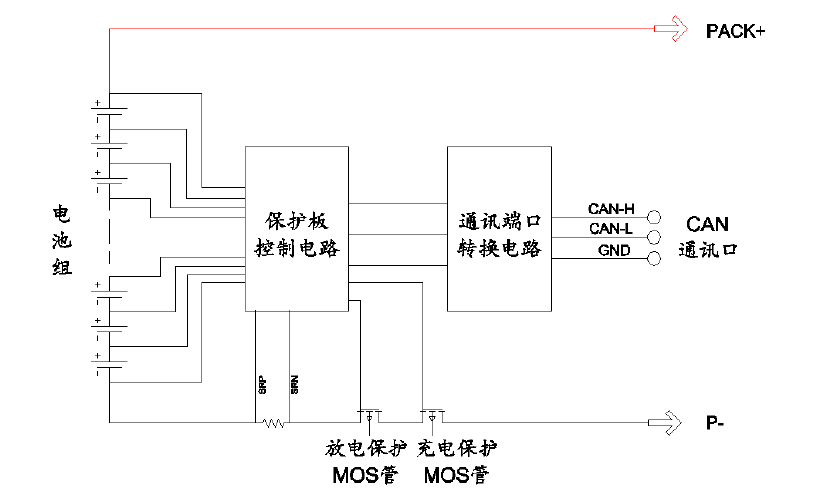
Protection schematic diagram

Motherboard top-level wiring diagram
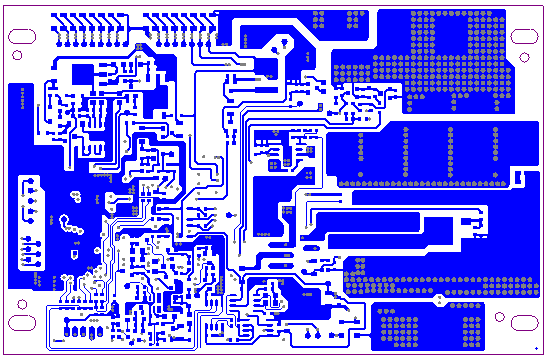
Motherboard bottom wiring diagram

Size 130*85 Unit: mm Tolerance: ±0.5mm
Protection board thickness: less than 15mm (including components)
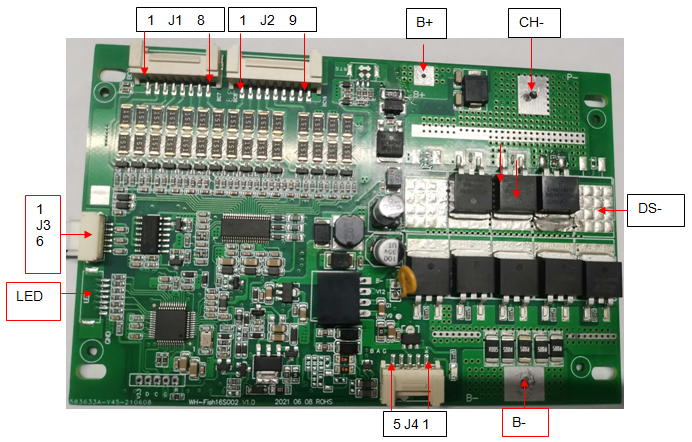
Protection board wiring diagram
|
Item |
Details |
|
|
B+ |
Connect to Positive Side of the pack. |
|
|
B- |
Connect to Negative Side of the pack. |
|
|
CH- |
Charging Negative Port. |
|
|
DS- |
Discharging Negative Port. |
|
|
J1(low end) |
1 |
Connect to Negative of Cell 1. |
|
2 |
Connect to Positive Side of Cell 1. |
|
|
3 |
Connect to Positive Side of Cell 2. |
|
|
4 |
Connect to Positive Side of Cell 3. |
|
|
5 |
Connect to Positive Side of Cell 4. |
|
|
6 |
Connect to Positive Side of Cell 5. |
|
|
7 |
Connect to Positive Side of Cell 6 |
|
|
8 |
Connect to Positive Side of Cell 7 |
|
|
J2(high end) |
1 |
Connect to Positive Side of Cell 8 |
|
2 |
Connect to Positive Side of Cell 9 |
|
|
3 |
Connect to Positive Side of Cell 10 |
|
|
4 |
Connect to Positive Side of Cell 11 |
|
|
5 |
Connect to Positive Side of Cell 12 |
|
|
6 |
Connect to Positive Side of Cell 13 |
|
|
7 |
Connect to Positive Side of Cell 14 |
|
|
8 |
Connect to Positive Side of Cell 15 |
|
|
9 |
Connect to Positive Side of Cell 16 |
|
|
J3 |
1 |
NTC2 (10K) |
|
2 |
||
|
3 |
NTC2 (10K) |
|
|
4 |
||
|
5 |
NTC2 (10K) |
|
|
6 |
||
|
LED |
reserved |
|
|
J4
|
1 |
Switch wire, connected to the positive pole |
|
2 |
|
|
|
3 |
GND1 |
|
|
4 |
CANH(No communication matching resistor) |
|
|
5 |
CANL(No communication matching resistor) |
|

Battery connection sequence diagram
Warning: When connecting the protective plate to the battery cells or removing the protective plate from the battery pack, the following connection sequence and regulations must be followed; if operations are not performed in the required order, the components of the protective plate will be damaged, resulting in the protective plate being unable to protect the battery. core, causing serious consequences.
Preparation: As shown in Figure 11, connect the corresponding voltage detection cable to the corresponding battery core. Please pay attention to the order in which the sockets are marked.
Steps to install protective board:
Step 1: Solder the CH- line and DS- line to the CH- and DS- pads of the protection board respectively without connecting the charger and load;
Step 2: Connect the negative pole of the battery pack to B- of the protection board;
Step 3: Connect the positive terminal of the battery pack to B+ of the protection board;
Step 4: Connect the battery pack and battery rows to J1 of the protection board;
Step 5: Connect the battery pack and battery rows to J2 of the protection board;
Step 6: Charge and activate.
Steps to remove the protective plate:
Step 1: Disconnect all chargers\loads
Step 2: Unplug the battery pack and battery strip connector J2;
Step 3: Unplug J1 of the battery pack battery strip;
Step 4: Remove the connecting wire connecting the positive electrode of the battery pack from the B+ pad of the protective plate
Step 5: Remove the connecting wire connecting the negative electrode of the battery pack from the B- pad of the protective plate
Additional notes: Please pay attention to electrostatic protection during production operations.
|
|
Device type |
type |
encapsulation |
brand |
Dosage |
Location |
|
1 |
patchIC |
BQ7694003 |
TSSOP44 |
TI |
1PCS |
U1 |
|
2 |
patchIC |
APM32F103CBT6 |
LQFP48 |
APM |
1PCS |
U2 |
|
3 |
Patch MOS tube |
CRSS042N10N \TO263 |
TO263 |
Huarunhui |
8PCS |
M3 M4 M5 M7 M8 M9 M10 M11 |
|
4 |
PCB |
Fish16S002 V1.0 |
130*85*1.6mm |
|
1PCS |
|
Note: If SMD transistors and MOS tubes are out of stock, our company may replace them with other models of similar specifications.

1.Wenhong company logo;
2 Protection board model - (This protection board model is Fish16S002, other types of protection boards are marked, there is no limit to the number of characters in this item)
3. The number of battery strings supported by the required protection board - (this model of protection board is suitable for 17S battery packs);
4 Charging current value - 20A means the maximum support for continuous charging is 20A;
5 Discharge current value - 40A means maximum support for continuous 40A charging;
6 Balance resistance size - fill in the value directly, for example, 100R, then the balance resistance is 100 ohms;
7 Battery type - one digit, the specific serial number indicates the battery type as follows;
|
1 |
Polymer |
|
2 |
LiMnO2 |
|
3 |
LiCoO2 |
|
4 |
LiCoxNiyMnzO2 |
|
5 |
LiFePO4 |
8 Communication method - one letter represents a communication method, I represents IIC communication, U represents UART communication, R represents RS485 communication, C represents CAN communication, H represents HDQ communication, S represents RS232 communication, 0 represents no communication, this product UC stands for UART+CAN dual communication;
9 Hardware version - V1.0 means the hardware version is version 1.0.
The model number of this protection board is: WH-Fish16S002-16S-20A-40A-75R-4-C-V1.0. Please place the order according to this model number when placing bulk orders.
1. When performing charge and discharge tests on the battery pack with the protective board installed, please do not use a battery aging cabinet to measure the voltage of each cell in the battery pack, otherwise the protective board and battery may be damaged. .
2. This protection board does not have a 0V charging function. Once the battery reaches 0V, the battery performance will be severely degraded and may even be damaged. In order not to damage the battery, the user should not charge the battery for a long time (the battery pack capacity is greater than 15AH, and the storage exceeds 1 Months) When not in use, it needs to be charged regularly to replenish the battery; when in use, it must be charged in time within 12 hours after being discharged to prevent the battery from being discharged to 0V due to self-consumption. Customers are required to have an obvious sign on the battery casing that the user regularly maintains the battery.
3. This protection board does not have reverse charging protection function. If the polarity of the charger is reversed, the protection board may be damaged.
4. This protective board shall not be used in medical products or products that may affect personal safety.
5. Our company will not be responsible for any accidents caused by the above reasons during the production, storage, transportation and use of the product.
6. This specification is a performance confirmation standard. If the performance required by this specification is met, our company will change the model or brand of some materials according to the order materials without further notification.